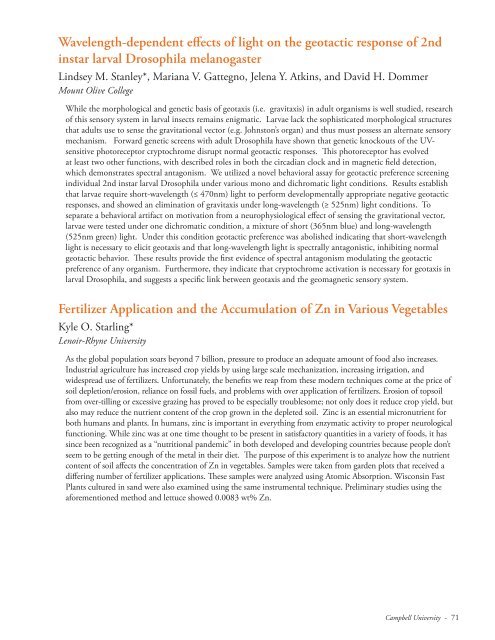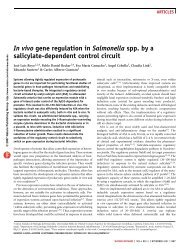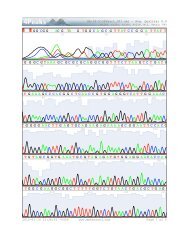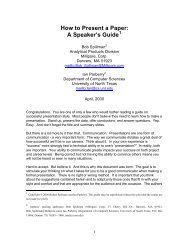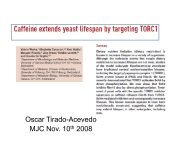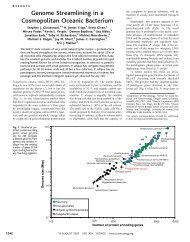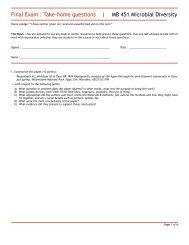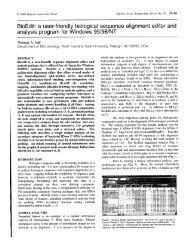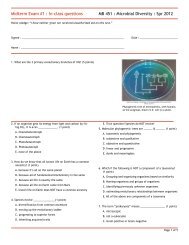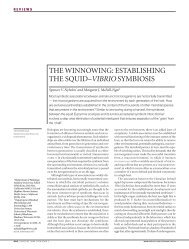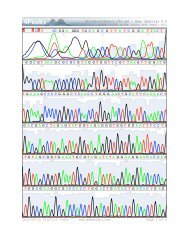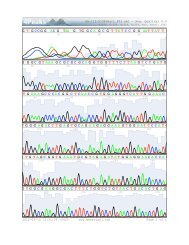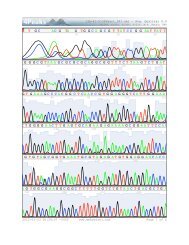Schedule and Program - North Carolina Academy of Science
Schedule and Program - North Carolina Academy of Science
Schedule and Program - North Carolina Academy of Science
You also want an ePaper? Increase the reach of your titles
YUMPU automatically turns print PDFs into web optimized ePapers that Google loves.
Wavelength-dependent effects <strong>of</strong> light on the geotactic response <strong>of</strong> 2ndinstar larval Drosophila melanogasterLindsey M. Stanley*, Mariana V. Gattegno, Jelena Y. Atkins, <strong>and</strong> David H. DommerMount Olive CollegeWhile the morphological <strong>and</strong> genetic basis <strong>of</strong> geotaxis (i.e. gravitaxis) in adult organisms is well studied, research<strong>of</strong> this sensory system in larval insects remains enigmatic. Larvae lack the sophisticated morphological structuresthat adults use to sense the gravitational vector (e.g. Johnston’s organ) <strong>and</strong> thus must possess an alternate sensorymechanism. Forward genetic screens with adult Drosophila have shown that genetic knockouts <strong>of</strong> the UVsensitivephotoreceptor cryptochrome disrupt normal geotactic responses. This photoreceptor has evolvedat least two other functions, with described roles in both the circadian clock <strong>and</strong> in magnetic field detection,which demonstrates spectral antagonism. We utilized a novel behavioral assay for geotactic preference screeningindividual 2nd instar larval Drosophila under various mono <strong>and</strong> dichromatic light conditions. Results establishthat larvae require short-wavelength (≤ 470nm) light to perform developmentally appropriate negative geotacticresponses, <strong>and</strong> showed an elimination <strong>of</strong> gravitaxis under long-wavelength (≥ 525nm) light conditions. Toseparate a behavioral artifact on motivation from a neurophysiological effect <strong>of</strong> sensing the gravitational vector,larvae were tested under one dichromatic condition, a mixture <strong>of</strong> short (365nm blue) <strong>and</strong> long-wavelength(525nm green) light. Under this condition geotactic preference was abolished indicating that short-wavelengthlight is necessary to elicit geotaxis <strong>and</strong> that long-wavelength light is spectrally antagonistic, inhibiting normalgeotactic behavior. These results provide the first evidence <strong>of</strong> spectral antagonism modulating the geotacticpreference <strong>of</strong> any organism. Furthermore, they indicate that cryptochrome activation is necessary for geotaxis inlarval Drosophila, <strong>and</strong> suggests a specific link between geotaxis <strong>and</strong> the geomagnetic sensory system.Fertilizer Application <strong>and</strong> the Accumulation <strong>of</strong> Zn in Various VegetablesKyle O. Starling*Lenoir-Rhyne UniversityAs the global population soars beyond 7 billion, pressure to produce an adequate amount <strong>of</strong> food also increases.Industrial agriculture has increased crop yields by using large scale mechanization, increasing irrigation, <strong>and</strong>widespread use <strong>of</strong> fertilizers. Unfortunately, the benefits we reap from these modern techniques come at the price <strong>of</strong>soil depletion/erosion, reliance on fossil fuels, <strong>and</strong> problems with over application <strong>of</strong> fertilizers. Erosion <strong>of</strong> topsoilfrom over-tilling or excessive grazing has proved to be especially troublesome; not only does it reduce crop yield, butalso may reduce the nutrient content <strong>of</strong> the crop grown in the depleted soil. Zinc is an essential micronutrient forboth humans <strong>and</strong> plants. In humans, zinc is important in everything from enzymatic activity to proper neurologicalfunctioning. While zinc was at one time thought to be present in satisfactory quantities in a variety <strong>of</strong> foods, it hassince been recognized as a “nutritional p<strong>and</strong>emic” in both developed <strong>and</strong> developing countries because people don’tseem to be getting enough <strong>of</strong> the metal in their diet. The purpose <strong>of</strong> this experiment is to analyze how the nutrientcontent <strong>of</strong> soil affects the concentration <strong>of</strong> Zn in vegetables. Samples were taken from garden plots that received adiffering number <strong>of</strong> fertilizer applications. These samples were analyzed using Atomic Absorption. Wisconsin FastPlants cultured in s<strong>and</strong> were also examined using the same instrumental technique. Preliminary studies using theaforementioned method <strong>and</strong> lettuce showed 0.0083 wt% Zn.Campbell University - 71


